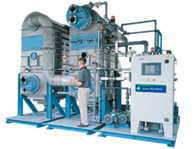Wastewater Disposal Options
 After the first prudent steps of reducing and recycling wastewaters, a company inevitably has to deal with their disposal. There are four general options for wastewater disposal:
After the first prudent steps of reducing and recycling wastewaters, a company inevitably has to deal with their disposal. There are four general options for wastewater disposal:
1. Sewer Discharge
2. Off-Site Hauling
3. Separation Technologies
4. Evaporation
1. Sewer Discharge
Even if a company has the resources to own and manage a chemical treatment facility on-site, this option, today, is almost nonexistent for direct discharging to a septic system, a local river or lake, and often times even to a municipal treatment facility (POTW). Even if municipal treatment is a viable option, the onus of compliance still remains with the generator. As new regulations take effect, local regulatory agencies continue to decrease the allowable limits for existing contaminants as they add new contaminants to their list. With each change, it is the generator that must absorb the burden of monitoring, documenting and proving sewer compliance.
These ever-tightening restrictions on wastewater chemistries can also have a potentially negative impact upon a manufacturing process. Consequently, companies often feel that outside authorities are wielding control over their manufacturing decisions, as well as their wastewater disposal. As local laws change (often times overnight) to eliminate industrial wastewaters from the sewer, sewer discharge becomes - at best - only a short-lived disposal solution.
2. Off-Site Hauling
Hauling off-site appears attractive, because it requires no investment in capital equipment, and the costs are easily identifiable. You pay as you dispose. However, the costs, like the liabilities, are typically high. A company is forever held responsible and liable for wastewater it generates (known as "Cradle-to-Grave"). This risk is potentially staggering and, therefore, most companies today do not consider hauling a long-term disposal solution.
3. Separation Technologies
This is normally an in-house, two-step process. The first step attempts to selectively remove unwanted contaminants from wastewater, and in the process creates two, separate waste streams. The second step then involves disposal of the two waste streams. This process creates the following:
- The water phase ("permeate") This stream is sent to drain and must meet local sewer regulations.
- The concentrate phase ("retentate") This stream must be hauled off-site or be handled with a secondary operation on-site. Using evaporation as the secondary operation dramatically reduces the costs and liabilities of hauling the stream off-site.
Evaporation, as a secondary operation, is particularly appropriate when added to an already installed Separation system or when a new Separation installation must handle enormous volumes of wastewater. In contrast, evaporators offer a simple, stand-alone approach that can easily handle all of the wastewater generated in applications that produce moderate-to-large volumes. While the concentrate phase is hauled off-site, the water phase is sent to drain and must meet sewer regulations. Again, you are back to the burden of sewer compliance! Because separation technologies do not eliminate the increasing difficulties inherent with sewer discharge, they are often times considered to be short-term solutions.
Separation Technologies have two major categories. Both of these technologies have disposal limitations that they share in common, as well as specific restrictions that are unique to each approach. The two categories of Separation Technology are as follows:
a. Physical Separation
b. Chemical Separation
a. Physical Separation
Physical Separation utilizes complex capital equipment (of different methodologies) to physically separate contaminants from the wastewater. Physically separating the contaminants from the wastewater creates two separate streams. One stream is hauled off-site, and the other stream is sent to sewer. Again, the generator is faced with the burden of sewer compliance!
Sub-categories of Physical Separation include the following technologies:- Ultrafiltration or Nanofiltration
- Reverse Osmosis
- Ion Exchange Filter Technology
- Original volume is not reduced, but merely segregated into two separate waste streams, each requiring its own regulatory compliance
- Permeate stream must meet sewer compliance
- Retentate stream requires on-site, secondary operation--or off-site hauling
- Cannot easily handle multiple, varying waste streams - i.e.,waste stream specific
b. Chemical Separation / Treatment
Chemical treatment, in some form, was one of the first technologies used for the disposal of water-based wastes. There are still situations in which chemical treatment is a viable solution, such as huge volumes or consistent streams involving metals. But today many generators are seeking alternatives to chemical treatment, either as a direct replacement or as a complement (i.e., segregating certain waste streams, such as oily waters). Newer alternatives are pursued primarily because of the typical complexity of chemical treatment and, more importantly, because the treated discharge is still accountable to sewer regulations.
Sub-categories of Chemical Treatment include the following technologies:- Polymer Flocculation
- Emulsion Breaking
- pH Adjustment
- Full Waste Treatment
- Constant commitment to the chemical management of the treatment system
- Expertise
- Manpower
- Complexity
- Additional Chemicals
- After treatment, water discharge is still accountable to sewer regulations and surcharges
- Streams problematic for chemical treatment can be segregated for evaporation
- Can be labor intensive and require licensed operators
4. Evaporation
After considering the options for wastewater disposal, most environmental experts agree that evaporation offers industry the simplest and most effective long-term approach. In addition, evaporation offers tremendous flexibility and versatility - for both current as well as future manufacturing and disposal needs.
Contact: Sales at 603-668-7111, sales@samsco.com ~ Service at 603-668-7111 ext 7111 or 216-400-8207, service@samsco.com
Home | About Us | Products | Services | Information & Resources | Contact Us
Samsco Water Evaporator II |
WasteSaver (Vacuum Distillation) |
Envirostill MVR |
Water Treatment Technologies |
Poly Atmospheric Evaporators |
Auxiliary Equipment
© Copyright
SAMSCO. All rights reserved. A Senney Enterprises Company:
Met-Chem, STD Specialty Filters, Lamports Filter Media, Murray Fabrics, Poly Products, Auto Technology, Samsco, Lakeside Water Treatment, Micropure Filtration, Jaxon Filtration, American Ecotech, Custom Instrumentation Services Corp., Ambilabs, AQ Matic.
